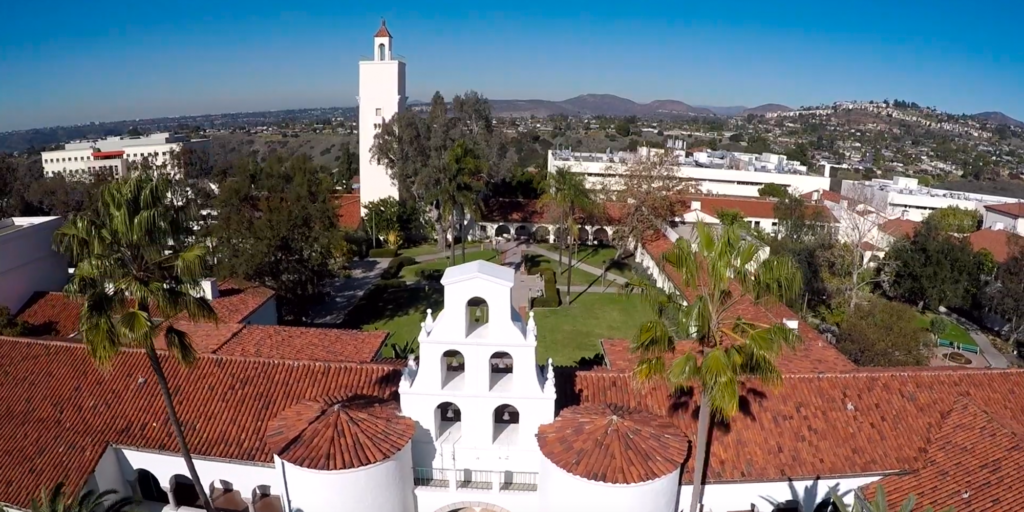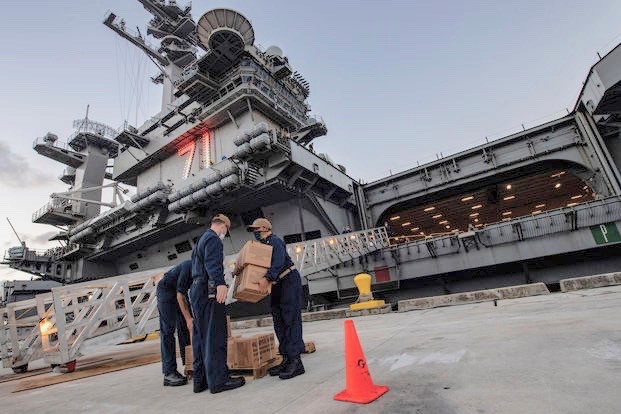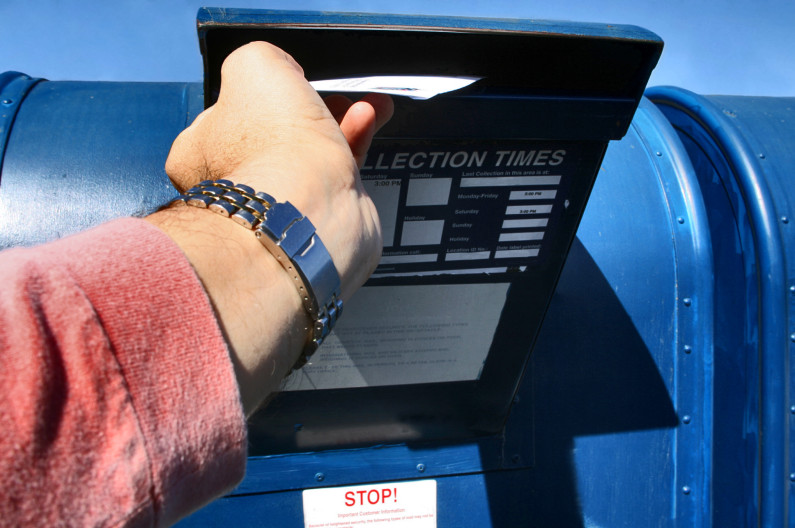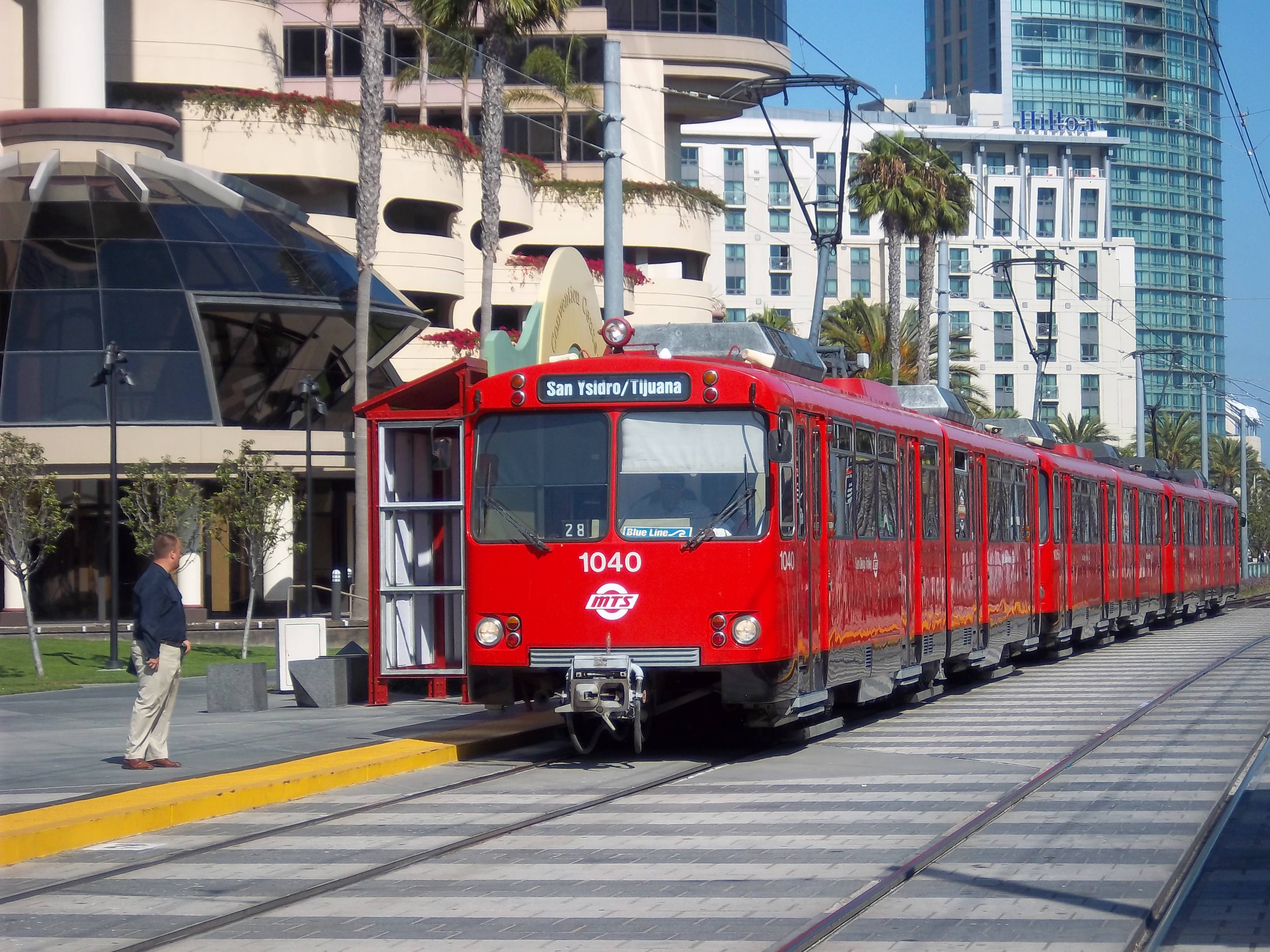Daily Business Report-April 30, 2020
The coronavirus pandemic has accelerated California’s move to an all vote-by-mail election option. (Photo via iStock)
California prepares for an
all vote-by-mail election in November
by Ben Christopher | Calmatters
All eyes are on the governor who, with an executive order, could make California’s upcoming election an “all-mail” affair
This coming November, every one of California’s more than 20 million registered voters may receive a ballot in the mail — whether they ask for one or not. In fact, many election administrators and advocates say it’s inevitable.
“It’s not a question of ‘if,’ said Kim Alexander, the president of the California Voter Foundation. “But ‘how.’”
California is already ahead of the curve when it comes to voting from home. In the March primary election, 75 percent of voters got a ballot in their mailbox. But the exigencies of social distancing are putting pressure on state lawmakers to round that up to 100 percent, ensuring that every registered voter has the option to cast a ballot without having to physically crowd into a polling place.
A bill from Palo Alto Democratic Assemblyman Marc Berman would ensure just that. But with most state legislators sheltering in place until at least early May, all eyes are on the governor who, with an executive order, could make the upcoming election an all-mail affair.
Earlier this month, Joe Holland, president of the California Association of Clerks and Election Officials and top election official in Santa Barbara County, sent Gov. Gavin Newsom a letter requesting that he ink a new edict, declaring the November contest an “all-mail ballot election.”
Even if mass gatherings are permitted in November — something Newsom says is unlikely — county election officials say time is of the essence. Ballots have to be ordered, voter rolls assembled, polling places secured.
“The consensus for November 2020 is that California is going to go all vote-by-mail — and we should. We don’t want to have a Wisconsin debacle,” Holland said, referring to the April 7 presidential primary where some voters reported waiting in line for five hours. Since then at least three dozen voters and polling workers in Wisconsin have tested positive for COVID-19.
The governor’s press office has not responded to a request for comment about prospects for a California all vote-by-mail election.
Even an “all-mail” election in California isn’t quite what it sounds like — it wouldn’t really be without a brick-and-mortar option. For those who need some extra help exercising their right to vote, state law requires counties to set up a certain number of in-person polling places.
Through Holland, the association also asked Newsom to grant them the authority to radically scale back that requirement. And therein lies the current rub.
Some advocates warn that an insufficient number of drop-off sites and vote centers could leave many voters — particularly those from underrepresented demographic groups — either unable to vote or stuck in long lines at the few remaining in-person locations.
“Waiving the state’s in-person voting standards will potentially disenfranchise tens, if not hundreds, of thousands of California voters,” union president Bob Schoonover, whose chapter of the Service Employees International Union represents tens of thousands of public sector workers across Southern California, wrote in a letter to Secretary of State Alex Padilla earlier this month.
Like so many debates of the COVID-era, it’s a disagreement that pits constitutional rights once thought to be non-negotiable against the prescriptions of public health.
“We’re trying to find the right balance of response that gives voters as much choice as possible, but also keeps them safe, and frankly, which is also implementable in the short number of months that the counties have to gear up,” said California Common Cause interim director Kathay Feng.
The coronavirus pandemic has injected new urgency into the national conversation about voting by mail, with some states now making it easier for voters to cast their ballots while self-isolating at home — and others not, and getting sued for it.
Despite evidence that making it easier to vote remotely does not benefit one party over another, the debate has taken on a partisan bent.
Weighing in earlier this month, President Trump urged Republicans to fight “very hard” against the expansion of vote-by-mail opportunities, claiming without evidence that such a system has “tremendous potential for voter fraud” and that “for whatever reason” such systems don’t “work out well for Republicans.”
The president’s views notwithstanding, recent polling has found strong majorities of Americans believe voters ought to be able to cast their ballots by mail without an excuse — though results are split on whether a majority of Republicans feel the same way.
But in California, there is little debate in policy-making circles about the merits of vote-by-mail elections.
Throughout April, Secretary of State Padilla — the administrator in chief of the state election system and, like Gov. Newsom, a Democrat — convened roughly 80 election officials, experts and advocates. They met, remotely, of course, in daily conference calls to game out how California might hold a statewide election during a full-blown pandemic.
Subgroups splintered off to hammer out every last logistical detail. Would registration deadlines be changed? How will each voter’s language preference be determined? Self-adhering envelopes that risk gumming up ballot-counting machines versus those sealed by pathogen-packed spit — how should counties decide?
Jonathan Stein, a program manager for the Asian Law Caucus’ voting rights program, was part of that task force. He said there was unanimity on at least one issue.
“There seemed to be almost universal agreement that we need to send every single voter a vote-by-mail ballot,” he said.
The question is, what other options will be available too?
Election rights advocates say in-person polling places offer a vital service to voters who don’t speak English, who experience some kind of disability, who don’t have a fixed address, who recently moved or who simply don’t feel comfortable with or do not understand the vote-by-mail process.
“There are a lot of communities that depend on polling places and polling centers,” said Mike Young, political director at the California League of Conservation Voters. In California, in-person voters skew poorer, younger and less white than the average voter.
An insufficient number of polling places could jeopardize public health even further, Young added. Like Holland, he pointed to Wisconsin as a cautionary tale. “People are anticipating that this is going to be an insanely high-turnout election.”
California voting rights advocates seem to have at least the tacit support of the state’s top election official.
“I think people who need or prefer an in-person option deserve it,” Padilla told KQED earlier this month. “And so we’re going to have to work really hard with counties to ensure we maintain as much in-person voting as we can.”
But county registrars argue that such requirements may put voters and poll workers at unnecessary risk.
“Quite frankly if we had an election tomorrow I wouldn’t be within a hundred feet of a polling place,” said Holland in Santa Barbara.
There are also practical questions about space and staffing, both of which are severely limited by the pandemic. Polling places are often hosted in schools, senior centers, and the garages of private homes — most of which are likely off the table now. The typical poll worker is a retiree, a cohort particularly at risk of severe COVID-19 complications.
Santa Barbara County is preparing to reduce the number of in-person locations from the 86 that were open in March to around five. Holland’s office may use the registrar’s three offices and then try to secure a handful of additional sites and the necessary poll workers.
“I don’t know if I can find three other facilities,” he said. “I have 15 staff and that’s when they’re here and healthy and right now three or four are out sick.”
Assemblyman Berman’s bill said his bill does not yet address in-person polling site requirements, but that the “first move shouldn’t be to weaken existing in-person voting requirements.” He urged state and county officials to be “creative” in finding locations and staff.
In the meantime, he said, some additional guidance from the governor could be helpful.
Newsom has already issued an executive order mandating that all voters in two upcoming special elections receive ballots in the mail. Though the order “encouraged” counties “to make in-person voting opportunities available,” they were given the freedom to do so “in a manner consistent with public health and safety.”
The two elections, a Senate race in Riverside County and a congressional contest north of Los Angeles, is showcasing how counties may differ in how they administer elections during a pandemic. In the congressional race, split between Los Angeles and Ventura counties, there will be at least a dozen locations where voters can drop off ballots in-person.
In Riverside County, home to the special Senate district, there will be only two physical drop-off points and no polling places or vote centers where voters can have their questions answered or their errors corrected.
“That’s a perfect illustration of what will happen if we give election officials full discretion,” said Stein.
_________________________________

San Diego State reports $42 million
in losses associated with pandemic
by Brenden Tuccinardi, senior staff writer, The Daily Aztec
San Diego State will face new financial realities in the coming fiscal year as the coronavirus pandemic is expected to decrease tuition revenue and bring changes to the state budget timeline and appropriations.
Already, the university reported $42 million in lost revenue and expenses due to COVID-19, according to an email sent by President Adela de la Torre and Chief Financial Officer Agnes Wong Nickerson on Monday.
The majority of the lost revenue constitutes housing, meal plan and parking reimbursements, while the remainder was unbudgeted costs. A similar or greater amount of lost revenue is expected in the coming fiscal year, according to the email.
“We have developed and carried out a thoughtful and necessary initial response plan for the near and long-term to mitigate the financial impact of the pandemic on our institution and community,” the email said.
The university has implemented a hiring chill on all open administrative positions in accordance with California State University system guidance, deferred non-critical construction projects, extended travel restrictions to May 31 and tapped into one-time reserves set aside for economic uncertainty.
The university has also requested assistance from FEMA and applied for a number of federal, state and philanthropic sponsors grants.
_________________________________
La Jolla groups hire attorneys
to oppose UC San Diego building project
by Dave Schwab | sdnews.com
Reacting to UC San Diego’s controversial proposal to build five new multi-story buildings on-campus, two La Jolla groups opposed have hired legal representation, joining three other civic groups in banding together to try and have the project paused.
La Jolla Shores Association City advisory group and Black Horse Homeowners Association, have both retained attorneys to represent them in ongoing negotiations between the university and La Jollans. Residents are arguing the Future College Living and Learning Neighborhood project’s bulk and scale is excessive and will lead to unmitigated impacts on traffic and access that must be more fully addressed.
The project, proposed on a parking lot adjacent to La Jolla Playhouse, is designed to provide residential life and administrative space for a new undergraduate college, with approximately 2,000 undergraduate beds, classrooms, an estimated 1,200 underground parking spaces, and a conference and retail space.
The new development, consisting of three nine- to 11-story buildings located along the campus edge, and two taller 16- and 21-story buildings located in the interior of the site to the east, would have a conference on top of one of the buildings and a public market at ground level.
Read more…
_________________________________
Future of the old Palomar Hospital
property to be determined in 2020
Sometime later this year, the Escondido City Council will be presented with plans to redevelop the 13.8-acre site of the former Palomar Hospital. What is there now will be razed and replaced with 258 family apartments, 90 senior apartments, 72 three-story row homes and 90 three-story villas — 510 units in all, according to the third iteration of plans that have been submitted. An additional 12,000 square feet of commercial will be housed in a separate building.
_________________________________
County rolls out testing, tracing,
treatment strategy against COVID-19
The county of San Diego is rolling out a new strategy in its fight against the COVID-19 pandemic. The “T3” strategy will address three crucial areas: testing, tracing and treatment.
While treatment options for the novel coronavirus are still being developed, the county’s Health and Human Services Agency is focusing on isolating people with confirmed COVID-19 infections and quarantining their close contacts. HHSA is also working to increase the region’s testing and contact tracing capabilities.
“We continue to expand our team of contact tracers,” said HHSA Director Nick Macchione. “The number of tracers has surpassed 100 and this week, an additional 20 tracers will be added. These are our disease detectives and a critical component of our T3 strategy.”
To assess and increase testing capabilities, the county has organized a Laboratory Testing Task Force of local hospitals, relevant clinics and commercial laboratory systems. Right now, labs in the region can test more than 3,400 specimens per day. The County Task Force has set a goal of testing nearly 5,200 people a day, with that figure based on Harvard research being used by the state and federal government to set COVID-19 testing numbers.
_________________________________
CIT’s $3 milion investment expected to create
1,350 affordable housing units for county
CIT and its Pasadena-based banking subsidiary announced a $3 million investment in support of the Local Initiatives Support Corporation of San Diego (LISC)’s Neighborhood Catalyst Fund.
CIT’s investment is expected to help create 1,350 affordable housing units for low-to-moderate income residents of San Diego County.
CIT’s support of the Neighborhood Catalyst Fund will result in multiple multi-family rental housing and mixed-use projects across San Diego County over the next decade Currently, the LISC San Diego Neighborhood Catalyst Fund has closed on its first loan of $5.5 million for a new 114-unit affordable housing project in City Heights that is expected to open by 2023.
_________________________________
Cleaning the USS Kidd

_________________________________

USS Theodore Roosevelt prepares to return to sea
NAVAL BASE GUAM (April 29, 2020) – Hundreds of sailors began the transition from quarantine and isolation to the aircraft carrier USS Theodore Roosevelt on Wednesday, as the San Diego-based ship prepares to return to sea after a bow-to-stern deep cleaning process.
More than 4,000 sailors who tested negative for COVID-19 have been in quarantine in hotels off base. It will take several days to move all of them back onboard.
After the ship’s arrival to Guam on March 27, approximately 700 sailors remained on board to maintain critical ongoing operations and begin the cleaning. Since then, the ship underwent an aggressive, multi-pronged cleaning regimen, which balanced effective decontamination with protecting the ship’s critical systems. Spaces were vacated for seven days – four days longer than the minimum recommended by the Centers for Disease Control – before being thoroughly disinfected. For spaces that were continuously operational, sailors cleaned the area before leaving it, while the incoming sailors cleaned it immediately upon arrival.
Meanwhile, Commander 7th Fleet, Joint Region Marianas, U.S. Naval Hospital Guam, Naval Base Guam and the government of Guam coordinated to isolate and quarantine the ship’s sailors in phases, in accordance with recommended Centers of Disease Control and Prevention (CDC) standards.
“Our mission is to make sure the fighting force in the fleet is ready to go at all times,” said Capt. Maria Young, commanding officer of the U.S. Naval Hospital Guam. “I appreciated the sailors’ patience throughout this whole process, as we worked with one another to maintain the health and readiness of the crew and to get the Roosevelt back to sea. We are happy to help.”
To return to the ship, the 4,000 sailors must have completed their period of quarantine or isolation, and tested negative twice. Sailors will return to the ship in waves, beginning with those responsible for critical services on board. Meanwhile, the 700 sailors who have been cleaning and running essential services will begin their isolation.
The transition of crews involved significant coordination, to ensure social distancing and maintain the cleanliness of the ship. Portions of the crew were carefully selected to return to the ship to establish a healthy foundation.
“The stay behind crew successfully built a ‘bubble’ around the ship, that can now be turned over to the clean crew,” said Cmdr. Zach Harry, the Roosevelt’s chief engineer. “The crew will now create a boundary to keep the coronavirus out. This clean bubble must now be defended.”
Theodore Roosevelt departed its home port of San Diego on Jan. 17 for a scheduled Indo-Pacific deployment.



